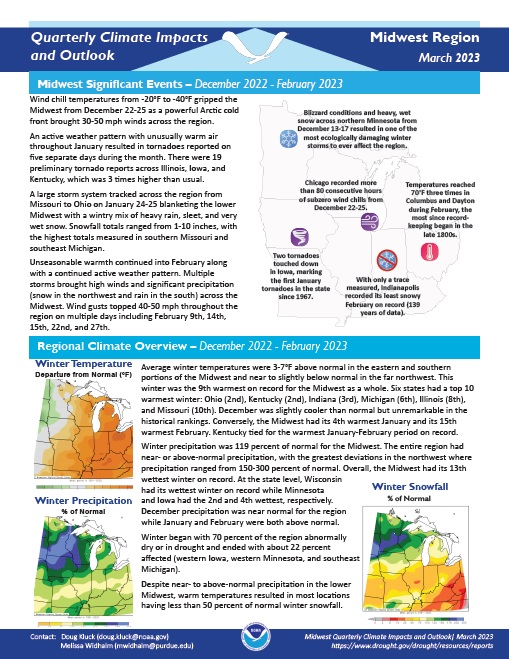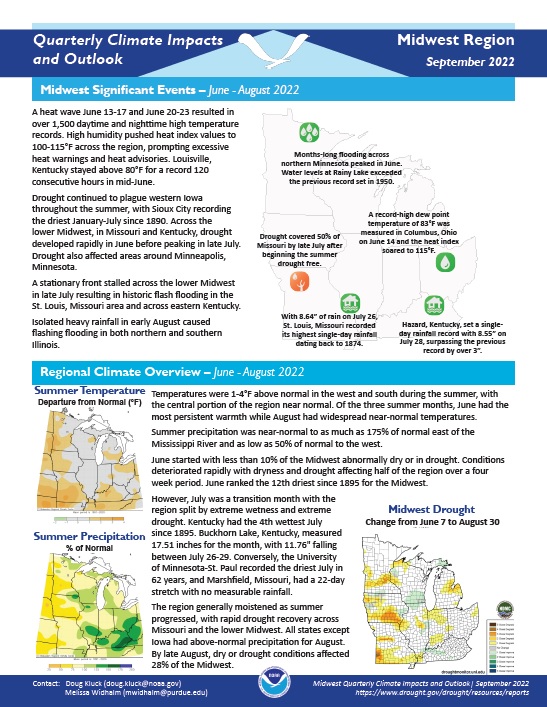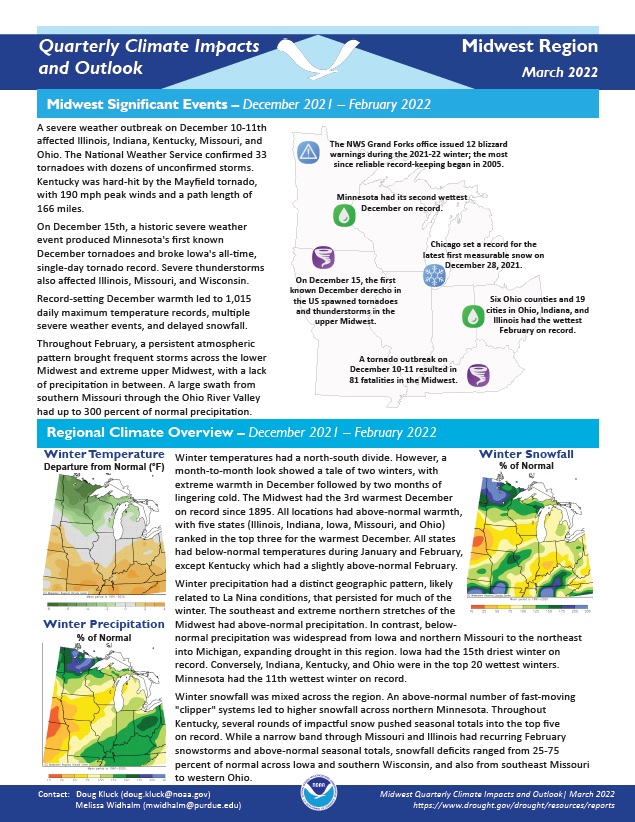Quarterly Climate Impacts and Outlook for the Midwest Region for March–May 2024. Dated June 2024.
Spring temperatures were 1-4°F above normal across the northwestern Midwest and up to 6°F above normal in the eastern half of the region. Spring precipitation was above normal for the Midwest. Iowa, Minnesota, and Wisconsin had their 4th wettest spring on record.
Quarterly Climate Impacts and Outlook for the Midwest Region for December 2023–January 2024. Dated March 2024.
Winter temperatures were 4-8°F above normal across the lower Midwest and up to 12°F
above normal across the upper Midwest. The Midwest, Iowa, Minnesota, Wisconsin, and
Michigan had the warmest winter on record. Winter precipitation was near average for the Midwest, oscillating between wet and dry across the region from month to month. Minnesota had a record-wet December. Illinois had its second driest February.
Quarterly Climate Impacts and Outlook for the Midwest Region for September–November 2023. Dated December 2023.
Fall temperatures were near normal in the east, with temperatures 1–3°F above normal in the west. Month-to-month, temperatures were near or above normal, with no notable areas of cooler temperatures. Fall precipitation was 70% of normal for the Midwest. Deficits of 4–8 inches were widespread across the lower Midwest, while areas around the Minnesota-Wisconsin border were up to 4 inches above normal for fall.
Quarterly Climate Impacts and Outlook for the Midwest Region for June–August 2023. Dated September 2023.
Summer temperatures were near normal for most of the Midwest, with slightly above-normal temperatures in the west and slightly below-normal temperatures in the east. Summer precipitation was 84% of normal for the Midwest. Deficits of 4–10 inches were widespread across the northwest, while surpluses of 2–8 inches were observed across the south-central and eastern Midwest.
Quarterly Climate Impacts and Outlook for the Midwest Region for March–May 2023. Dated June 2023.
Average spring temperatures were near to slightly above normal for most of the Midwest, except in Minnesota, where temperatures were up to 4°F below normal for spring. Spring precipitation was 80% of normal for the Midwest.
Quarterly Climate Impacts and Outlook for the Midwest Region for December 2022–February 2023. Dated March 2023.
Quarterly Climate Impacts and Outlook for the Midwest Region for September–November 2022. Dated December 2022.
Average fall temperatures were 1–2°F above normal across the upper Midwest, near normal across the central Midwest, and 1–2°F below normal across the lower Midwest. Most of the Midwest had less than 75 percent of normal precipitation for fall, with the south-central Midwest, western Iowa, and southern Minnesota accumulating less than 50 percent of normal.
Quarterly Climate Impacts and Outlook for the Midwest Region for June–August 2022. Dated September 2022.
Temperatures were 1–4°F above normal in the west and south during the summer, with the central portion of the region near normal. Summer precipitation was near normal to as much as 175% of normal east of the Mississippi River and as low as 50% of normal to the west.
Quarterly Climate Impacts and Outlook for the Midwest Region for March–May 2022. Dated June 2022.
Spring precipitation was near- to above-normal across the Midwest, with most areas at 75%–125% of normal precipitation. The upper Midwest and southern Missouri were the wettest locations with over 150% of normal precipitation. Spring temperatures averaged 1–4°F below normal in the northwest and 1–3°F above normal in the southeast, with near-normal conditions in between.
Quarterly Climate Impacts and Outlook for the Midwest Region for December 2021 - February 2022. Dated March 2022.











